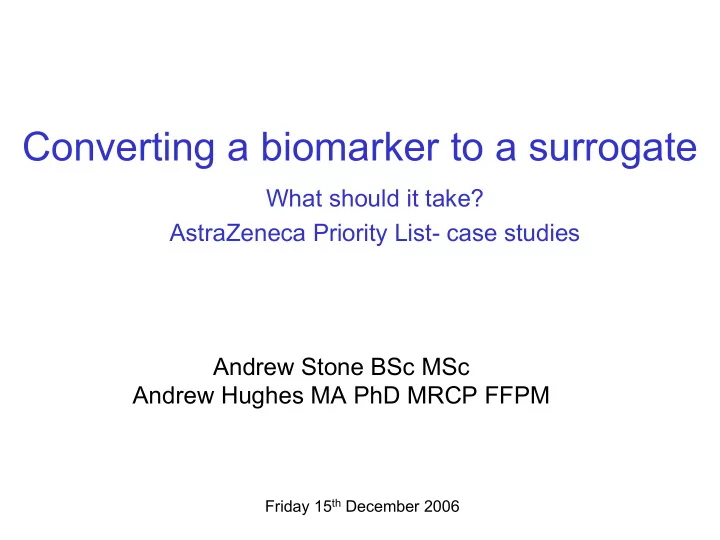

Converting a biomarker to a surrogate What should it take? AstraZeneca Priority List- case studies Andrew Stone BSc MSc Andrew Hughes MA PhD MRCP FFPM Friday 15 th December 2006
The need for surrogate endpoints • In many settings, the primary clinical endpoint takes large, long term trials – e.g. early breast and prostate cancer • In other settings the underlying effect of therapy is obscured by later line therapies • To reduce time and to bring effective medicines to patients quickly, in an area of high unmet need, requires use of intermediate or surrogate endpoints
Clarity on terminology Biomarkers Measured prior Response after to therapy receiving therapy Predictive markers Biomarkers hope Pharmacodynamic markers Incremental benefit of therapy to elevate to surrogates Today’s discussion depends on level of expression e.g. PSA e.g. her-2 gene copy no.
Surrogate Biomarkers *Controlled Clinical Trials 22:485–502 (2001)
How do we establish surrogacy Goal of analysis is to be confident that if we observe a treatment effect on the surrogate it will translate into a clinical benefit – Acts a substitute • A strong correlation within an individual is necessary but not sufficient • Longer survival in responders vs non- responders would not necessarily deem response a surrogate endpoint
Newer Approaches to Surrogacy • Prentice criteria are restrictive • Newer approaches 1 directly address the question of surrogacy – Can an intermediate endpoint act as a substitute • Assess how robustly between group changes on one endpoint predict for later changes on another 1 The evaluation of surrogate endpoints: Burzykowski T, Molenburghs G, Buyse M (eds). Springer. New York, 2005
Relation between tumour response to first-line chemeotherapy and survival in advanced colorectal cancer: a meta-analysis R 2 = 0.38 [0.09-0.68]
Much stronger evidence for surrogacy in same setting, in absence of active 2 nd line therapy. R 2 =0.97 Buyse et al: Progression-free survival as a surrogate for Overall Survival (OS) in patients with advanced colorectal cancer. An analysis of 3159 patients randomized in 11 trials. ASCO 2005
Using methodology to quantitate uncertainty in prediction – Ovarian cancer http://www.fda.gov/cder/drug/cancer_endpoints/ovarian/buyse.pdf: Burzykowski T & Buyse M - Pharmaceut. Statist. 2006;5:173-186
Estimation of a “Surrogate Threshold Effect” HR of 0.55 on PFS provides high confidence of eventual OS effect
Pause for thought • To prove surrogacy we need data from large trials – Exactly the trials we are hoping to avoid • Will therefore conversion of biomarkers to surrogates take much longer than we hoped? • Many surrogates used routinely today (e.g. BP and cholesterol) were not subject to the rigorous assessment described
Conditional approval • Requires endpoints that are reasonably likely to predict clinical benefit; but not proof. Does this require 97.5% certainty? • Proposal: Using Surrogate Threshold Effect (STE) methodology; use a change in biomarker which enables conclusion that there is a 70%/80% probability that it will translate into clinical benefit? • Issue: Rare diseases, with high unmet need, where meta-analyses of by necessity large trials will not be possible?
Pharmacodynamic Biomarkers considered promising to characterise the STE -performance characteristics commensurate with clinical use -dynamic effect across drugs demonstrated Imaging Histopathology Blood borne FDG-PET* Ki67 Disease specific markers e.g. PSA DCE-MRI Cell Turnover index Circulating Tumour cells (proliferation-Ki67:Apoptosis-caspase 3) Circulating free DNA *already being tested for surrogacy by FDA-NIH-PhRMA consortium
DCE-MRI: Literature review •Intrasubject CV% ~25% •Gd uptake (K trans or IAUC) decreases in a dose-dependent way in rodent and human RODENT PHASE 1 HUMAN Vatalanib Drevs 2002 Morgan 2003 Combretastatin A4P Galbraith 2003 Galbraith 2003 AG-013736 Wilmes 2003 McShane 2004 ZD6126 Robinson 2003 Evelhoch 2004
Ki67: Unpublished review (AstraZeneca) •Intrasubject CV% =11% •Using ANOVA find significant relationship between Ki-67 and tumour response by diameter (p<0.0001) and RECIST (p=0.0004) n=>300
PSA: Published review R 2 = 0.66 [0.30-0.85] n=>2000 Collette L et al.; (2005) JCO, 23; 6139-6148 2005
Pharmacodynamic Biomarkers: Moving Forward (1) Request Regulatory Guidance for – Criteria to establish level of proof • depending on biological plausibility and extent of unmet need • Incorporate Surrogate Threshold Effect • employing conditional approval process with further trials to establish this benefit – Recommended nomenclature (2) Above would pave the way for pre-competitive collaboration between interested parties to collate requisite weight of evidence data to assess surrogacy of those pharmacodynamic biomarkers considered most promising
Recommend
More recommend